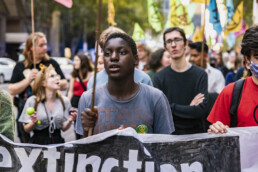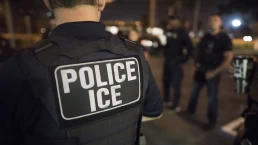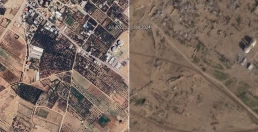Successful campaigns for change all need, require, and indeed must have youth.
By Michael Albert, Z Network
Roughly ten weeks until U.S. students will trek back to school, including college. What’s coming to NYU, Wisconsin, SF State, MIT, Howard, Pepperdine, Morehouse, Purdue, Loyola, Pace? What’s coming to Drake, Kansas State, Rutgers, Boston University, University of Chicago, Duke, Berkeley, Florida, Kent State? What’s coming to Reed, Bucknell, Colombia, Vanderbilt, Austin, Evergreen, Concordia, Yale, Jackson State – and all the rest?

Will students scale ivy walls and prowl campus corridors seeking change. Will students create tumult, turmoil, tension, and resistance? Will students evidence rejection and initiate revolt? That’s what ought to arrive this Fall. It’s what we can all hope will arrive. But will it?
Flash back, way back, so far back, all the way to May 1970–just yesterday. Richard Nixon announced the invasion of Cambodia. What was already intense campus unrest dramatically escalated. The national guard shot to death four students at Kent State University. Campuses erupted. Two were killed and twelve wounded at Jackson State. About 2,000 students were arrested in the first half of May 1970. Campuses were declared in a state of emergency in Kentucky, Ohio, Michigan, and South Carolina. At least a third of the nation’s nearly 3,000 colleges had strikes. Over 80% of all colleges and universities had protests. Approximately four million students and 350,000 faculty members actively participated in strikes. Buildings were shut down. Highways were blocked. Campuses were closed. Nixon’s Scranton Commission reported that roughly three quarters of all students supported the strikes. Pollsters reported that within campuses alone over a million people claimed to favor revolution and called themselves revolutionaries. In early 1971 the New York Times reported that four out of ten students thought a revolution was needed in the United States. This upsurge and the civil rights and then the black power movement, the women’s movement, the antiwar movement, and the youth rebellion behind it all, together threatened the very fabric of society and thereby helped to end a war as it twisted the country’s mentality inside out and upside down. Racism was under siege. Sexism was in retreat. Suburban culture was tottering. A gigantic war machine was slowed. Even capitalism had cracks. But the desire to attain a better world did not last sufficiently long or grow sufficiently wide and deep to replace Washington’s White House and Wall Street’s corporations which, instead, went on producing domination and greed. Capitalism’s institutional persistence slowly eroded and even devoured Sixties aspirations for solidarity and self management. “We want the world and we want it now. Now!” We didn’t get it.
Flash forward to this coming September. Imagine students back on campus. Do they discuss courses to take? Ways to hook up with new guys or gals? Upcoming athletic seasons? I’d be surprised if not, but will students’ also focus on war and peace? On global weather, water, and plastics? On why calamities afflict the poor so much worse than all others? On why there are poor at all? Will students on campus focus on why life in the world is so much less than it could be for the starving, the raped, the bombed, the unemployed, the heat-melted, the high-water-rising-drowned, and for those who work at jobs that rob dignity, stifle creativity, and subject souls to stupefying rule by others? Will students on campus talk about having no time to live, no space to be humane, and no meaning beyond the next crappy, cursing dollar? Will the main topic for students on campus this Fall be an envisioned future that is spiritually, emotionally, sexually, intellectually, ecologically, and also materially liberating? Will it be how they are going to win that envisioned future consistent with their working hard for everyone else to get there too.
Imagine students asking why their curriculums produce ignorance about international relations on top of ignorance about market competition’s violations of solidarity, sagacity, and sustainability. Imagine students deciding that enough is enough. Devils in command no more. Enough sadistic suicidal corporate commodification.
Maybe one particular student wears a funny hat and has a history of being aloof, but now shouts out grief, desire, hope, and anger. Perhaps another student looks as straight as a Pepsi commercial and has her high school class’s most likely to have a million friends diploma, but suddenly sings about how to upend masters of the universe. Maybe another student speaks, shrieks, or paints about floods drowning people’s hopes and about a rising tide of people’s compassionate creativity lifting people’s prospects. Maybe yet another student will write about resurgent racism and sullying sexism, and about combative communalism and fierce feminism and their time finally coming. Maybe students will hum new tunes, sing new lyrics, and rally, march, sit in, and occupy—all while waving a big, solid fist and creating a living, breathing community of respectful mutual aid in place of dismissive mutual recrimination. Maybe a few, and then more, and then so so many students will reach out in ways that pull still others in and never in ways that repel others away.
Imagine that students don’t just send emails to their friends and allies, don’t just tweet and TikTok others, but actually enter dorms, knock on every door, and initiate long talks. And then do it again, and again. Imagine they listen closely. They communicate clearly. And they patiently present carefully constructed arguments that address not only war, racism, sexism, poverty, and all the nightmarish patterns that afflict our lives, but also positive prospects that they prefer for on campus and for off.
Imagine students consciously and methodically earmark fraternity and sorority members, athletes, readers, writers, and scholars for conversation, incitement, and recruitment. Imagine they see their campuses as places from which to churn out activists. They see no higher calling than to make campus-wide critical dissent and innovative construction begin, accelerate, and, like a dream too long deferred, explode.
Imagine students school themselves outside the narrow bounds of their colleges’ borders and thereby envision an alternative to cutthroat competition and insular isolation. Students who teach themselves to describe a better alternative. Students who inspire others with their vision. Students who regularly refine their vision, and formulate and implement paths to reach it.
Imagine that students, by the new year, share many views and much spirit. Imagine them angry and also hopeful, sober and also laughing. They meet in dorm hallways and dining areas, on ball fields and in bedrooms, to form campus organizations, or, even campus chapters of a larger encompassing national community of organizations. Imagine the latter is called students for a democratic society—a new SDS—or maybe it even morphs itself to transcend its past and look forward to become, say, students for a participatory society, or even students for a participatory world where each chapter chooses its own local name. Dave Dellinger SPS, Emma Goldman SPS, Malcolm X SPS. And for that matter, Rosa Luxemburg SPS, Emiliano Zapata SPS, Ella Baker SPS, Eugene Debs SPS. And so on.
Imagine, in short, that students rise up with information, relentless focus, and inspiring abandon. Students become angry, militant, and aggressive, even as they also keep foremost in their expanding minds mutual concern and compassion.
Imagine all this tumult pumps into the already nationally growing U.S. dissent against war and economic injustice, against global ecological nightmare, and against ubiquitous anti social violence. Imagine aroused students knocking on everyone’s doors and pushing into neighborhood associations and union gatherings and church cells as a growing youthful branch of movement activism willing to break the laws of the land and push thoughts and deeds into revolutionary zones. Students who sing, dance, march, and law-break up a howling storm of desire and intent.
That youthful energy and insight is something the antiwar movement, the labor movement, the movement for gender and sexual liberation, and the movement against racism and fascism—the movements for local and worldwide rights and against environmental suicide, the movement for consumer rights and against corporate commodification, the resurgent labor movement for dignified work, and the movements for equity and against profit seeking market madness all need.
Successful campaigns for change all need, require, and indeed must have youth.
So imagine that young people, with time, energy, heart, and mind, discern that they are being coerced by society most often to become crushed victims, sometimes to become passive abettors, and occasionally to become active perpetrators of society’s injustices.
Imagine students seek more and other than to be bent by society’s pliers. Imagine they hunker down for the long haul. They equip themselves much better and orient themselves much more wisely than my generation of the Sixties ever did. They are smarter, more strategic, more persistent.
Imagine students not only reject statist regimentation and war, corporate alienation and greed, patriarchal sexism, ageism, and gender repression, and tribalistic sectarian inter-community racism and nationalism, but also carry their feelings of rejection into positive advocacy that undertakes innovation to bring to campuses not only small sub communities of dissent and rejection, but campus-wide communities of joyous and sustained commitment to positive vision. Being left, being radical, being visionary becomes synonymous with being caring, being right, and being true to self and others. That would be a ticket to a new world for everyone. That would be a ticket much better than old style graduation into a morally decrepit world all around us. This trip will be long. But why not step up now?
Of course there are obstacles. There’s massive media misinformation. There’s habituated personal passivity. There are campus rules, and there is state repression. But look around. Society is headed for hell. Such reasons to not step up, to not rise up, ought to seem comparatively insubstantial next to today’s injustice much less it’s suicide trek toward environmental disaster. But perhaps some other obstacles impede all the above stepping up.
First, there is doubt about winning and even about there being anything to win. There is doubt that a better world is even possible. And, even if technically possible, doubt that we humans can attain it. And, second, even if humanity could attain it, there is doubt about personally having anything to offer by way of helping that struggle. What can be done to overcome all these doubts? Develop and share immediate flexible demands and tactical plans. Orient choices of and sustain commitment to immediate flexible demands and tactical plans. Develop and share vision for better schools and even for better society. Develop and share vision for the new world we desire and for strategy to birth it. Develop and share answers to the very fair question, okay, what do you want? Yes, all of that.
More, isn’t a related but subtlety different obstacle to campus tumult, turmoil, tension, and resistance a considerable level of campus defeatism, depression, and aloofness? A kind of mindset that runs away from politics, that runs away from activism? A feeling that politics and activism are alienated, boring, and acrimonious realms that drain already overstretched and highly precarious lives? Isn’t this obstacle that many many students are not only unconvinced by activist formulations, but to preserve their own sanity they don’t even want to hear from “the left.” They often agree with “the left” but want to avoid “the left.” They want to ghost “the left.” They even energetically run from “the left.” What can “the left” do to overcome this obstacle to its own growth?
Perhaps “the left” can engage with young people via socially uplifting activities? Perhaps can directly address the actual feelings that block communication? Maybe a youthful surge able to grow and persist, to diversify and deepen in the various ways necessary to fourish will need to be a kind of home for students, a nourishing and not a hectoring environment. Perhaps it will need to be an exciting, welcoming, inspiring destination that people want to seek out and not a place they want to emotionally and socially avoid. Perhaps right up with offering vision, strategy, and program, “the left” needs to offer a patient, caring home, and not a frazzled, contentious, emotionally draining, denigrating jail of a different kind.
If all that, then perhaps back to college, and back to high school too, will indeed include tumult, turmoil, tension, resistance, rejection, and revolt. Perhaps it will more centrally feature than ever before vision-based, multi-focus, multi-tactic, strategically sustained movement that embodies humor, heart, mutual respect, support, and aid.
Perhaps it will liberate humanity and save our planet. Perhaps it will tell passive teachers of passivity there’s a new movement on campus. The old ways are over. You too, step up or step aside.
Imagine that.
Recent Posts
What To Do When You See ICE In Your Neighborhood
July 14, 2025
Take Action Now How can you deter the Trump administration’s immigrant deportation machine when it pops up in your community? Follow these…
ICE Campaign Of Violence Will Lead To More Deaths
July 14, 2025
Take Action Now Jaime Alanis’s death shows the horrific consequences of a secret police force behaving with utter impunity.By Natasha Lennard, The…
Hague Group: “Concrete Measures” or Sack of Cement? Will It Move to Sanctions, Peace Force and Ensuring Aid to Gaza?
July 13, 2025
Take Action Now Will the meeting in Colombia be a coalescence of global opinion driving states to just action — or just more rhetoric from various…
Why Are Democratic Lawmakers Still Meeting With Netanyahu?
July 12, 2025
Take Action Now Pictures show Democrats like Chuck Schumer standing next to Netanyahu, smiling.By Sharon Zhang, Truthout A bipartisan group of…




